The iShares Global REIT ETF (NYSEARCA:REET) tracks a basket of the largest real estate investment trusts worldwide. This is a market segment that has been under pressure since reaching an all-time high back in late 2021 amid a challenging macro backdrop with several headwinds including rising interest rates and concerns of a broader global growth slowdown.
That being said, we’re eyeing a shifting backdrop that we believe may pave the way for stronger returns going forward. Simply put, data pointing to easing inflation and the outlook for lower interest rates should be supportive of the broader real estate sector.
What we like about REET is its diversified exposure between market-leading U.S. names as well as international REITs that should benefit from stronger foreign currencies going forward.
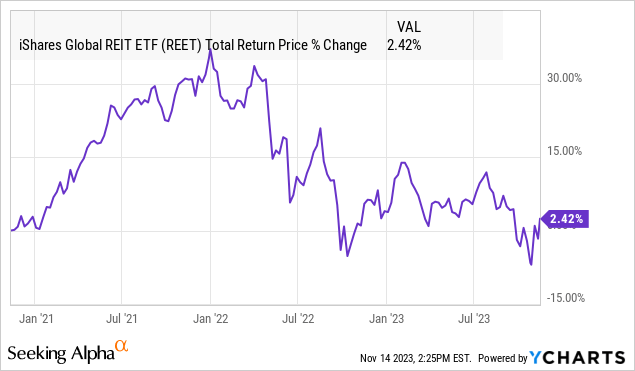
What is the REET ETF?
REET technically tracks the “FTSE EPRA NAREIT Global REITS Net Total Return Index”. This is a market free-float adjusted market capitalization-weighted methodology. Notably, there is a minimum market value threshold while REITs are screened to ensure the majority of their operating income through EBITDA is generated from real estate activities.
The idea of a “real estate investment trust” is that companies qualifying for such classification are permitted to deduct dividends paid to shareholders from their taxable income. By this measure, REITs have an incentive to maximize their distributions to upward of 100% of their income, to reduce their corporate tax liability. The structure is seen as a win-win for both the companies and shareholders by aligning the interest of long-term value creation.
In the case of REET, the fund and underlying index only include REITs from countries where organized legislation has been established.
The trend has been for a growing number of REITs worldwide over the past decade. Currently, REITs from the U.S. represent approximately 71% of the REET portfolio, followed by 7% in Japanese REITs, and 5% in REITS from the United Kingdom. Down the list, there is also exposure to countries like Australia and Singapore.
source: iShares 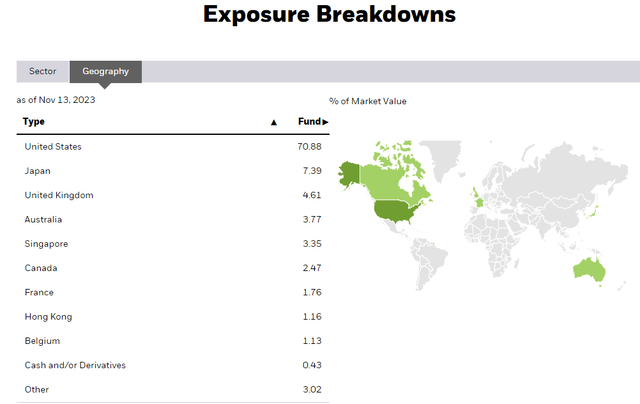
The breakdown here between geography and REIT sub-sectors is simply a reflection of the available universe of publicly traded real estate companies. On that point, retail REITs are the most well-represented within the fund at 19% of the weighting. Industrial REITs at 17% and multi-family residential REITs at 10%, along with Data Center REITs and Health Care REITs at 9% round out the top-5 sub-sectors.
Keep in mind that there is often some overlap here with REITs often dabbling across property types and even some assets that are in a grey area of classification.
source: iShares 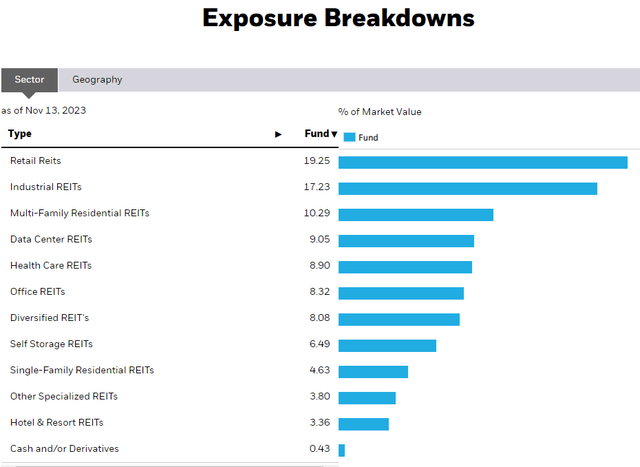
Going through the current portfolio, U.S. REITs dominate the top holdings with industrial warehouse and logistics leader Prologis (PLD) as the top holding with an 8% weighting. Data center giant Equinix (EQIX) has a 6% weighting, followed by the Health Care REIT Welltower (WELL).
Again, the positions here are based on each REIT’s market value, recognizing that the international REITs are spread out across the full 370 positions in the fund. We think the strategy here does a good job of capturing the global diversification considering many of these “U.S REITs” also hold foreign real estate properties.
Seeking Alpha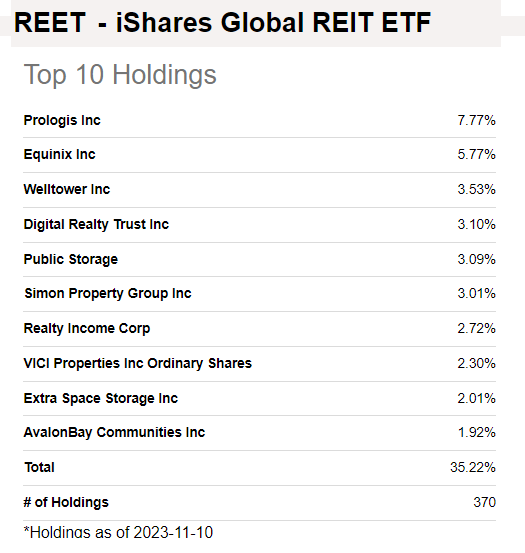
REET Performance
Naturally, with the “global” profile, the performance of REET is expected to be a mix between the U.S. REITs and returns from only international names. We can proxy these two segments through the Vanguard Real Estate ETF (VNQ) as a U.S. sector benchmark along with the Vanguard Global ex-U.S. Real Estate ETF (VNQI).
Over the past 5-years, REET has gained a cumulative 4.1% on a total return basis compared to an 18% return by VNQ against a -10% decline from VNQI. While international REITs have underperformed in recent years, we think that group could ultimately lead higher from here.
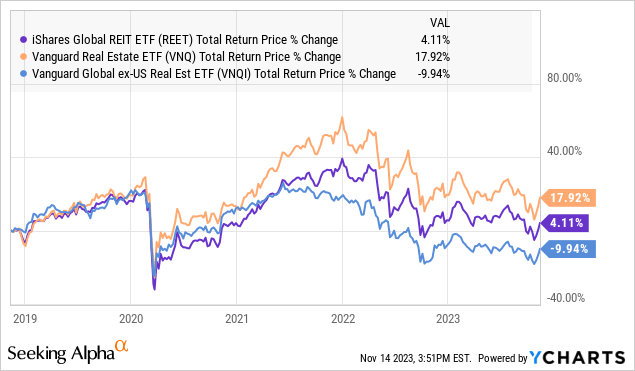
While REET’s dividend yield is currently listed at 2.5% is “modest” compared to the 4.5% yield in VNQ, the total return potential is the stronger point here.
The advantage of REET is that it captures the full spectrum of real estate opportunities through a more balanced approach, well-positioned to rally along U.S. REITs while also having exposure to the more unique foreign names.

What’s Next For REET?
In the context of the current market environment, we can highlight several developments as justifying a more bullish outlook for the REET ETF. Recent data suggests that inflation continues to ease in the U.S., even surprising to the downside of estimates with the latest October CPI report.
This is important as it helps ease concerns that the Fed would need to continue hiking rates which has been a major headwind for risk assets including real estate as an interest rate-sensitive sector in recent months.
The move is evident with long-term yields including the 10-year Treasury rate pulling back to under 4.5%, down more than 50 bps from the recent cycle hike. The interpretation here is that with room for disinflation to continue, the Fed has room to cut interest rates sooner rather than later into 2024, with some confidence that inflation is trending towards the 2% target.
This is a positive turn of events for REITs because it provides some flexibility on the funding side to pursue further expansion of their real estate portfolios, while also making the distribution yields from underlying names more competitive against cash returns.
source: CNBC
The other side of that dynamic is an ongoing selloff in the Dollar. This is a function of lower bond yields making USD relatively less attractive compared to real returns available internationally. This set is particularly positive for foreign stocks and the international REET that generate the bulk of their returns in foreign currencies.
source: finviz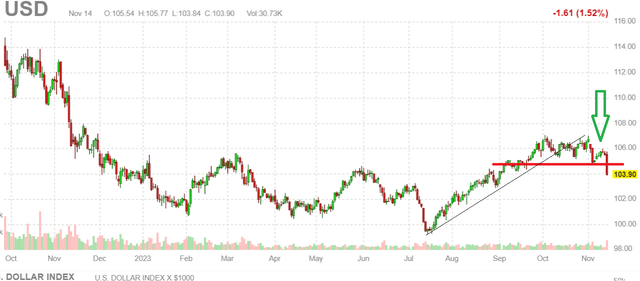
Overall, these factors are coming together to kickstart what we believe is still the early stages of a bigger rally in this market segment. REET rallied nearly 5% off the favorable October CPI news and is currently up 11% from recent lows. At the same time, the fund remains down more than -15% from highs near $26.00 earlier in the year highlighting the potential upside going forward.
The bullish case here is that global REETs benefit from both improving sentiment towards the sector while capturing the new macro tailwinds. A resilient global economy into 2024, able to avert fear of a recession or deteriorating economic conditions can be supportive of value creation by the underlying leading REIT players worldwide.
Seeking Alpha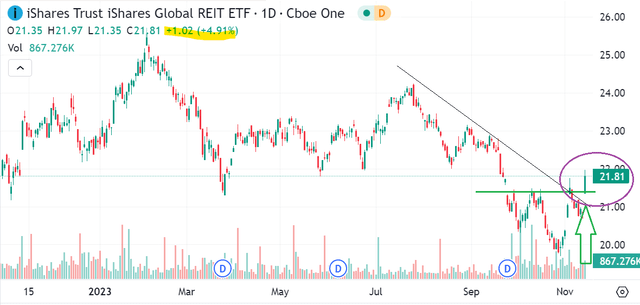
Final Thoughts
It’s likely been a frustrating couple of years for REIT investors, although there is a case to be made that the tide is finally turning.
The point addressed above between the next steps in Fed policy, the inflation outlook, trends in interest rates, and even the direction of the U.S. Dollar are key monitoring points. In terms of risks, a scenario where inflation somehow accelerates higher, driving renewed weakness in bonds with yields climbing higher would likely drive a new round of volatility to this segment.
Overall, we believe REET is a high-quality and low-cost fund that can work as a core long-term portfolio holding for investors.
Read the full article here












